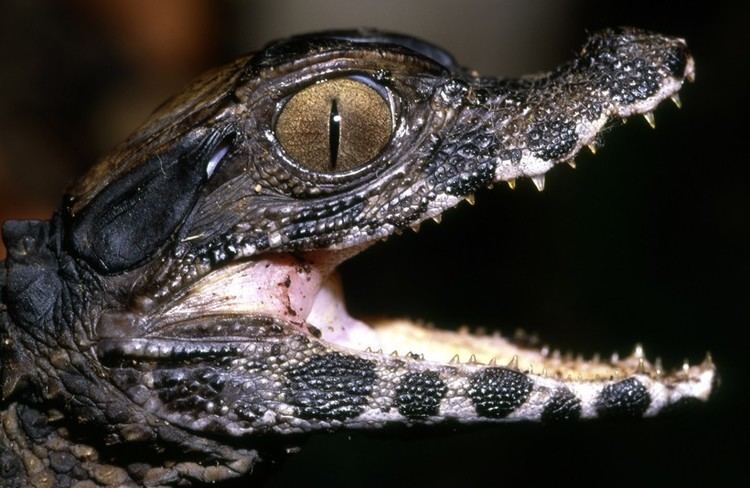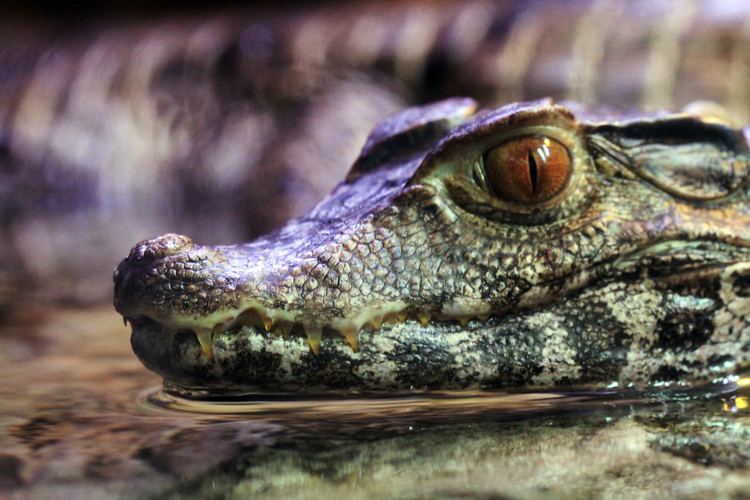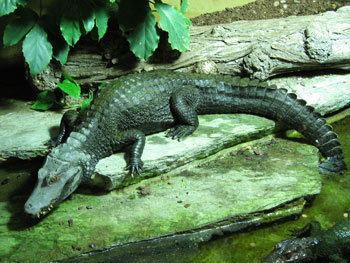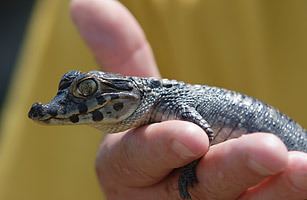Phylum Chordata Family Alligatoridae Scientific name Paleosuchus palpebrosus Rank Species | ||
 | ||
Similar Paleosuchus, Smooth‑fronted caiman, Reptile, Crocodiles, Caiman | ||
Feeding our cuvier s dwarf caiman on exhibit in reptile village zoo
Cuvier's dwarf caiman (Paleosuchus palpebrosus) is a small crocodilian from northern and central South America in the alligator family. It is found in Bolivia, Brazil, Colombia, Ecuador, French Guiana, Guyana, Paraguay, Peru, Surinam and Venezuela. It lives in riverine forests, flooded forests near lakes, and near fast-flowing rivers and streams. It can traverse dry land to reach temporary pools and tolerates colder water than other species of alligator. Other common names for this species include the musky caiman, the dwarf caiman, Cuvier's caiman and the smooth-fronted caiman. It is sometimes kept in captivity as a pet and may be referred to as the wedge head caiman by the pet trade.
Contents
- Feeding our cuvier s dwarf caiman on exhibit in reptile village zoo
- Etymology and taxonomy
- Description
- Distribution and habitat
- Behaviour and ecology
- Status and conservation
- Captive care
- References

Cuvier's dwarf caiman was first described by the French zoologist Georges Cuvier in 1807 and is one of only two species in the genus Paleosuchus, the other species being P. trigonatus. Their closest relatives are the other caimans in the subfamily Caimaninae. With a total length averaging 1.4 m (4.6 ft) for males and typically up to 1.2 m (3.9 ft) for females, Cuvier's dwarf caiman is not only the smallest extant species in the alligator and caiman family, but also the smallest of all crocodilians. An adult will typically weigh around 6 to 7 kg (13 to 15 lb). Its lack of size is partly made up for by its strong body armour, provided by the bony bases to its dermal scales, which provides protection against predators. Juvenile dwarf caimans mainly feed on invertebrates, but also small fish and frogs, while adults eat larger fish, amphibians and invertebrates, such as large molluscs. This caiman sometimes uses a burrow as shelter during the day and in the Pantanal may aestivate in the burrow in order to stay cool in the dry season. The female buries her eggs on a mounded nest and these take about three months to hatch. She helps the hatchlings to escape from the nest and provides some parental care for the first few weeks of their life. This caiman has a wide range and large total population and the IUCN lists its conservation status as being of "least concern".

Etymology and taxonomy

Cuvier's dwarf caiman was first described by the French zoologist Georges Cuvier in 1807 as Crocodylus palpebrosus from a type locality described as "Cayenne". Since then, it has been given a number of names by different authorities: Crocodilus (Alligator) palpebrosus (Merrem, 1820), Jacaretinga moschifer (Spix, 1825), Champsa palpebrosa (Wagler, 1830), Alligator palpebrosus (Dumeril and Bibron, 1836), Champsa gibbiceps (Natterer, 1841), Caiman palpebrosus (Gray, 1844), Caiman (Aromosuchus) palpebrosus (Gray, 1862) and Jacaretinga palpebrosus (Vaillant, 1898). Muller, in 1924, and Schmidt, in 1928, were the first to use the currently accepted name of Paleosuchus palpebrosus. No subspecies are recognised.

The genus Paleosuchus contains only two members, Paleosuchus trigonatus, commonly known as the smooth-fronted or Schneider's dwarf caiman, and Paleosuchus palpebrosus, both from South America. Paleosuchus is distinguished from other caimans in the alligator subfamily Caimaninae by the absence of an inter-orbital ridge and the presence of four teeth in the premaxilla region of the jaw where other species of caiman have five. The genus name Paleosuchus is derived from the Greek palaios meaning "ancient" and soukhos meaning "crocodile". This refers to the belief that this crocodile comes from an ancient lineage that diverged from other species of caiman some thirty million years ago. The specific name palpebrosus is derived from the Latin palpebra meaning "eyelid" and osus meaning "full of". This refers to the bony plates (palpebrals) present on the upper eyelids.

Common names include the musky caiman, the dwarf caiman, Cuvier's caiman and the smooth-fronted caiman, although the last of these is also used to refer to the closely related Paleosuchus trigonatus. In the pet trade, it is sometimes referred to as the wedge head caiman.
Description
Cuvier's dwarf caiman is the smallest living New World crocodilian. Males grow to a maximum length of about 1.6 metres (5 ft 3 in) while females do not usually exceed 1.2 metres (3 ft 11 in). The largest specimen on record measured 1.72 m (5.6 ft) in length. This may be an underestimate of the animal's maximum size as nearly all large adults have lost the tips of their tails and the largest specimen measured in the Pantanal region had a snout-to-vent length of 1.125 m (4 ft) (equivalent to a total length of 2.1 m (6.9 ft) with an intact tail). An adult will typically weigh around 6 to 7 kg (13 to 15 lb), around the same weight as a 6–12-month-old specimen of several larger species of crocodilians. The Cuvier's dwarf caiman has strong body armour on both the dorsal (upper) and ventral (lower) sides which may compensate for its small body size in reducing predation. The dermal scales that provide this protection have a bony base and are known as osteoderms.
The head has an unusual shape for a crocodilian, with a dome-shaped skull and a short smooth, concave snout with an upturned tip, the shape rather resembling the head of a dog. The upper jaw extends markedly further forward than the lower jaw. There are four pre-maxillary and fourteen to fifteen maxillary teeth on either side of the upper jaw and twenty-one or twenty-two teeth on each side of the lower jaw giving a total of about eighty teeth. The neck is relatively slender and the dorsal scutes are less prominent than in the smooth-fronted caiman (Paleosuchus trigonatus). The double row of scutes on the tail are small and project vertically. Adults are dark brownish-black with a dark brown head while juveniles are brown with black bands. The iris of the eye is chestnut brown at all ages and the pupil is a vertical slit.
The scutellation (arrangement of the scales) helps to distinguish Cuvier's dwarf caiman from Schneider's dwarf caiman (details of latter in brackets)
Distribution and habitat
Cuvier's dwarf caiman is native to tropical northern and central South America. It is present in the drainages of the Orinoco River, the São Francisco River and the Amazon River, and the upper reaches of the Paraná River and the Paraguay River. The countries in which it is found include Peru, Ecuador, Colombia, Venezuela, Guyana, Surinam, French Guiana, Brazil, Bolivia and Paraguay. The range of this species is rather larger than that of the sympatric smooth-fronted caiman, as it extends into Paraguay and includes a larger area of Brazil.
Cuvier's dwarf caiman is a freshwater species and is found in forested riverine habitats and areas of flooded forest around lakes. It seems to prefer rivers and streams with fast-flowing water, but it is also found in quiet, nutrient-poor waters in Venezuela and southeastern Brazil. It is able to travel quite large distances overland at night and sub-adult individuals have sometimes been found in isolated, temporary pools. In the northern and southern parts of its range, it is also found in gallery forests in savannah country, but it is absent from such habitats in Los Llanos and the Pantanal. Cuvier's dwarf caiman seems relatively tolerant of cool water compared to other species of alligator. During the day, individuals sometimes lie up in burrows but at other times rest on piles of rocks or sun themselves while lying, facing the sun, in shallow water with their backs exposed.
Behaviour and ecology
Cuvier's dwarf caiman is mainly nocturnal. Adults feed on fish, amphibians, small mammals, birds, crabs, shrimps, molluscs and other invertebrates, which they catch in the water or on land. Juveniles eat fewer fish, but also consume crustaceans, tadpoles, frogs and snails as well as land invertebrates, such as beetles. The prey is mostly swallowed whole and is ground up by stones in the gizzard. In the Pantanal, Cuvier's dwarf caiman aestivates in burrows during the dry season and is able to maintain its temperature at around 22 °C (72 °F) for days at a time.
Adult Cuvier's dwarf caiman are usually found singly or in pairs. The breeding of this species has been little studied but it does not appear to be seasonal in nature. The female builds a mound nest out of vegetation and mud somewhere in a concealed location and lays a clutch of from 10 to 25 eggs, hiding them under further vegetation. The incubation period is around 90 days and the sex of the hatchlings depends on the temperature of the nest during that time. When the eggs begin to hatch, the female opens the nest in response to the calls made by the young. Newly emerged juveniles have a coating of mucus and may delay entering the water for a few days until this has dried. Its continuing presence on their skin is believed to reduce algal growth. The female stays with the young for a few weeks after which time the hatchlings disperse. The young grow at the rate of about 8 to 10 cm (3 to 4 in) per year and reach sexual maturity at around eight years.
Cuvier's dwarf caiman is considered to be a keystone species whose presence in the ecosystem maintains a healthy balance of organisms. In its absence, fish, such as piranhas, might dominate the environment. The eggs and newly hatched young of Cuvier's dwarf caiman are most at risk and are preyed on by birds, snakes, rats, raccoons and other mammals. Adult caimans are protected by the bony osteoderms under the scales and their main predators are jaguars, green anacondas (Eunectes murinus) and large boa constrictors (Boa constrictor).
Status and conservation
Many crocodilians are hunted for their skins, but this is not the case with the Cuvier's dwarf caiman. This may be because the ventral skin in this species is too heavily armoured to make it easy to tan. Some individuals are killed by indigenous peoples for food and others, particularly in Guyana, are collected for the pet trade; but there is no evidence that populations are dwindling as a result. There are some threats to this species from habitat destruction, including the mining of gold, but these are not thought to be of great significance. The estimated total population is over one million individuals.
In its Red List of Threatened Species, the IUCN lists Cuvier's dwarf caiman as being of "Least Concern". This is because its range is extensive, covering much of northern and central South America, and although its population trend is unknown, it appears to be abundant in many of the localities in which it is found. It is listed in Appendix II of CITES.
Captive care
Cuvier's dwarf caiman can be kept as a pet, though providing suitable care is expensive and requires extremely large enclosures. In many countries, permits or licenses are necessary and most veterinarians have little experience of these exotic animals.
